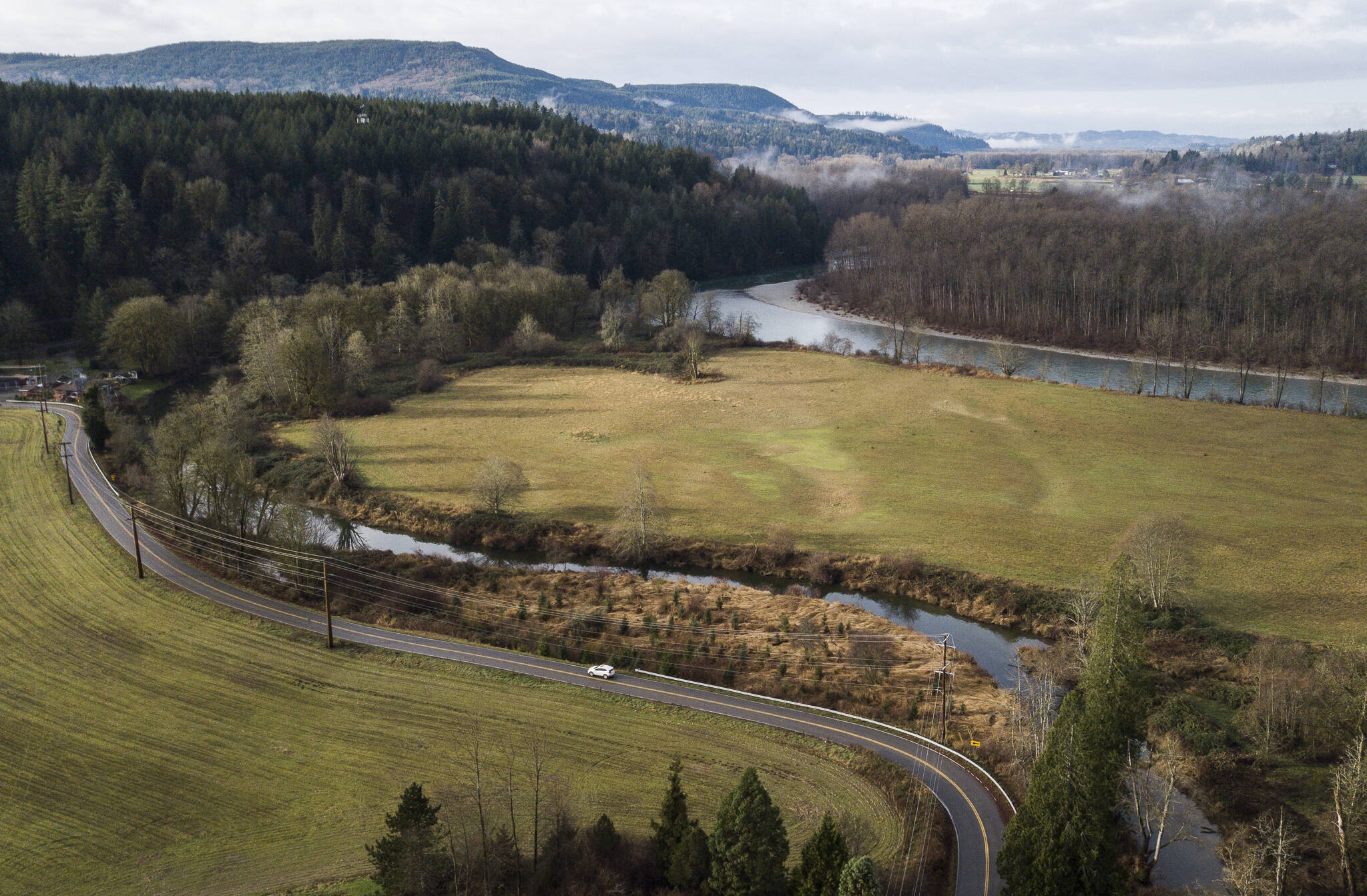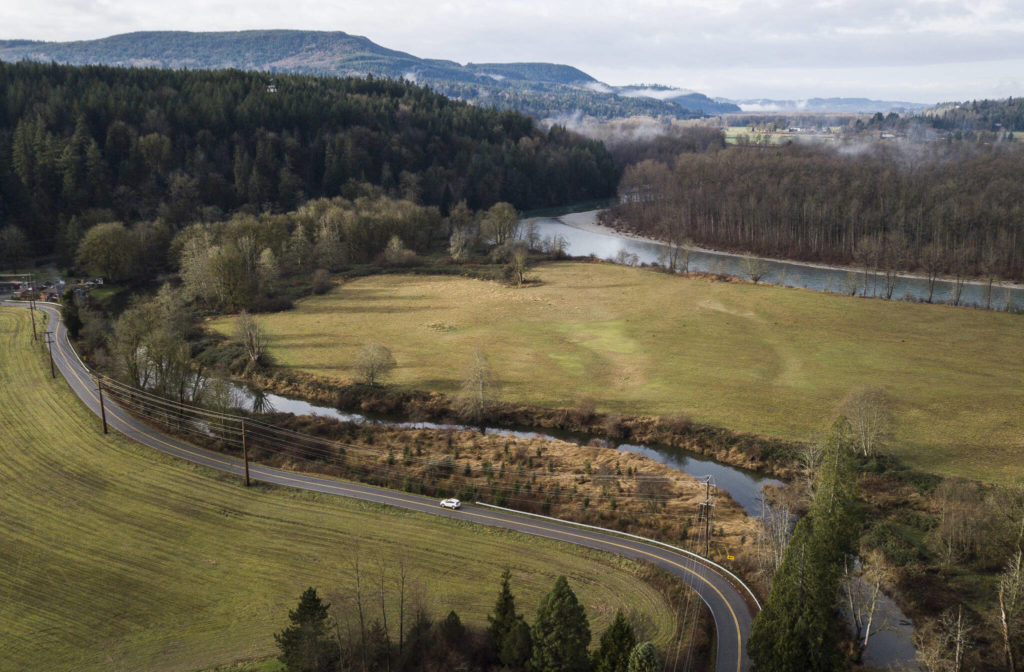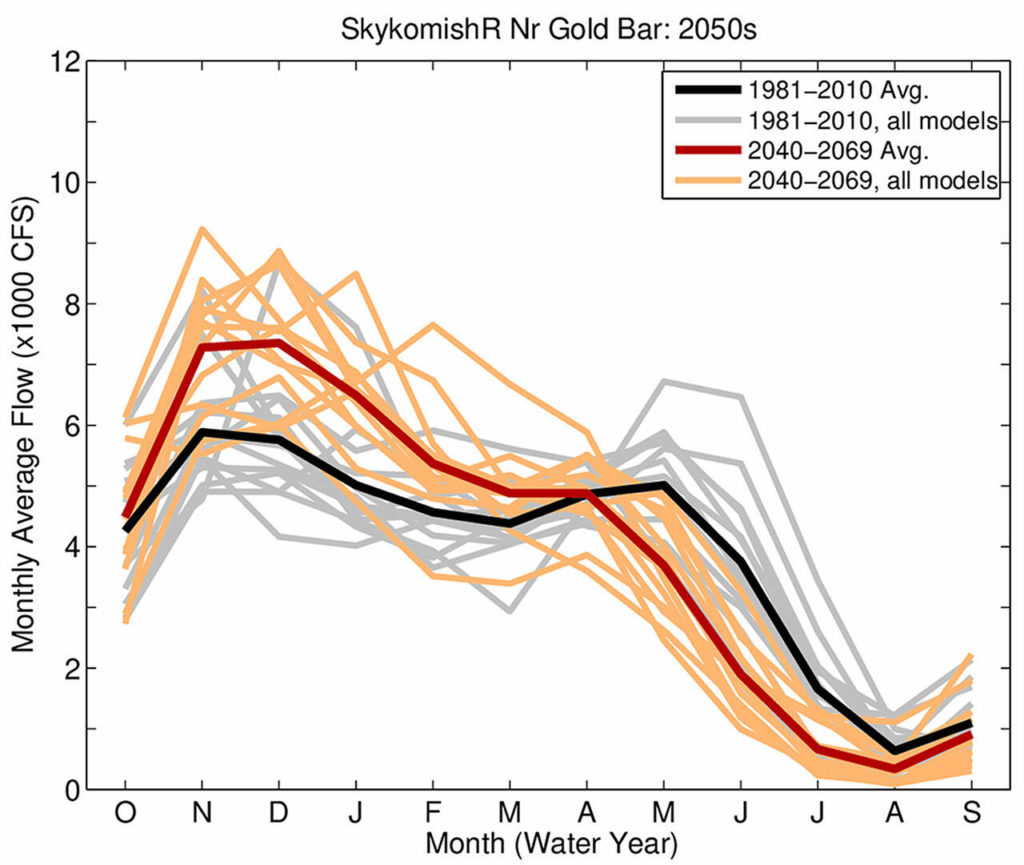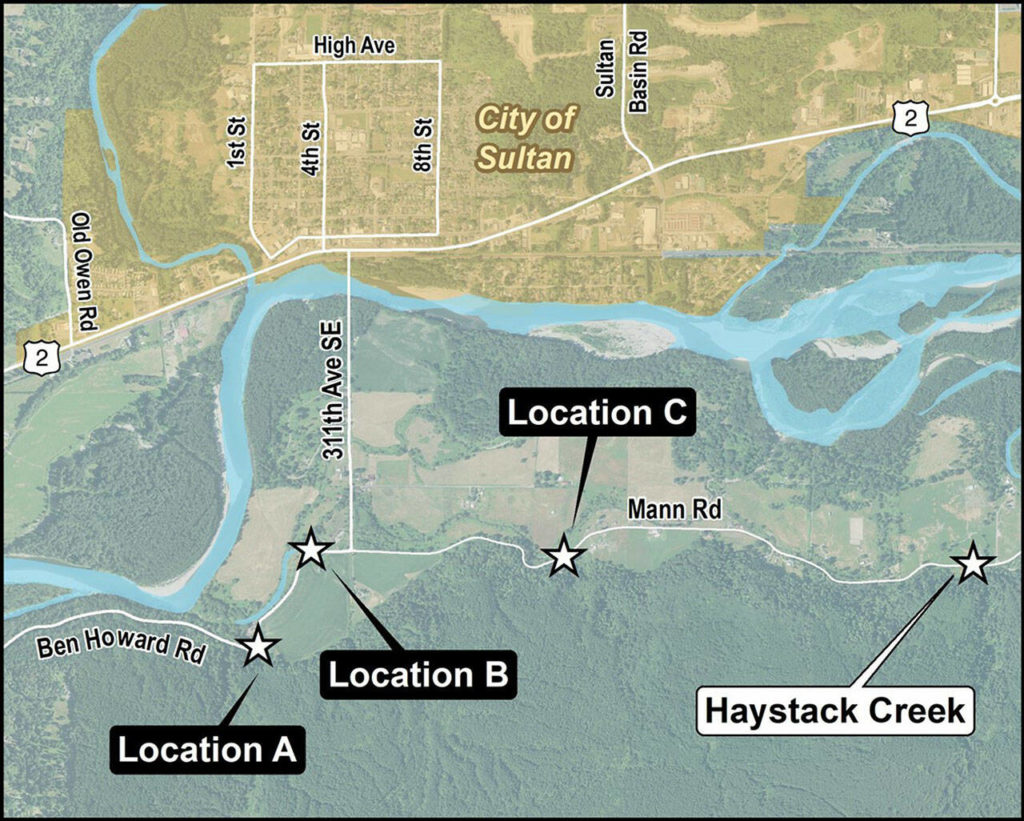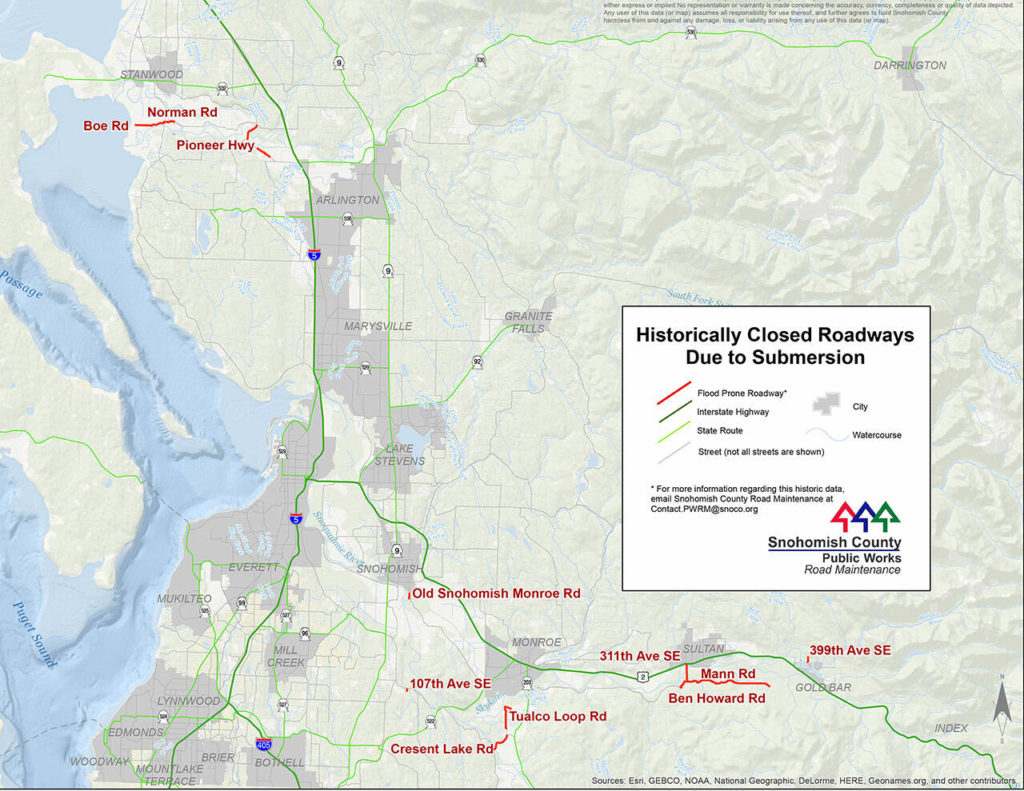When the water rises in Snohomish County, here are some things you should know:
Drive around a traffic barrier onto a road that’s under water, and you face a $426 fine.
The term “100-year flood” may not mean what you think it does.
And climate change is increasing the chance of extreme floods, like those that ravaged parts of Skagit and Whatcom counties and British Columbia in mid-November.
Things weren’t as catastrophic along the Skykomish River, where Lisa Hosesel Finley and her husband live. But there were three days that week when they couldn’t leave their Mann Road ranch south of Sultan.
“I’m drastically impacted by flooding,” said Finley, a firm believer that human-caused climate change is making matters worse in her rural neighborhood. She recalls the time that extreme mountain snowmelt led to an emergency release of water from Spada Lake reservoir. Water roared into the Sultan River, flooded streets in Sultan, then gushed into the Skykomish. “We were locked in for a week.”
That was in 2015, a year that rang alarm bells for Northwest climate scientists. Low snowpack had combined with a warmer-than-usual early summer — conditions they expect to be typical in the 2050s.
“We expect decreasing snowpack to be the biggest climate change effect on flooding in the near term, and changes in rain intensity to be more important later in the century,” said Guillaume Mauger, a research scientist with the University of Washington’s Climate Impacts Group. NASA research predicts climate change will intensify atmospheric rivers that swoop in off the Pacific to deluge the Northwest. Sea level rise also may contribute to flooding here, especially in river estuaries.
Rainfall records, like those measured at Paine Field in Everett, have shown a gradual shift this century. Summers are getting drier; winters and early springs wetter. But there is no solid record of extreme rainfall because it can be very localized. A downpour floods one spot, while a nearby location sees not a drop.
North Everett had two such “microbursts” in September 2019. The first came around noon and lasted about 19 minutes, recalled Souheil Nasr, utilities engineer manager with Everett Public Works. “Six hours later, we got hit by another one in the same few blocks that was just as intense,” he said. West Marine Drive flooded and was closed to traffic. Six hours later, just as crews were about to reopen the main thoroughfare, a second microburst hit.
“It was the equivalent of a 400-year event,” Nasr said, using a Federal Emergency Management Agency term indicating flood frequency.
Meteorologists aren’t fond of the FEMA description. If people hear “100-year-flood,” they often assume a flood of that magnitude will only occur once a century. In fact, it means there is a 1% chance of that occurrence within a given year. Or, as Snohomish County’s Flood Safety Guide explains it: “If your property is in or near a ‘100-year floodplain,’ there is a 26% chance that your home will be flooded sometime during your 30-year mortgage.”
Everett’s 2019 downpours burst pipes under Marine View Drive. Crews had to resurface the road. Recent infrastructure improvements, including stormwater pipes under the new Marine View Drive pedestrian bridge, have mostly eliminated that kind of problem, Nasr said.
The Climate Impacts Group predicts that, by 2055, what is now a 100-year-flood will become a 25-year-flood. Since 2017, Public Works has used that information to design new projects, Nasr said.
“But with storms, it’s a moving target,” he added. “You can’t plan for a Noah-type flood.”
Riverside woes
While city dwellers must sometimes cope with swamped streets and basements, some riverside residents are regularly besieged by floods.
Watershed Science and Engineering, a Seattle firm, looked at the potential for future flooding on six regional rivers with headwaters in the North Cascades, including the Snohomish and its tributary, the Skykomish. Among the findings: if climate trends continue, peak flows of the Skykomish at Gold Bar would increase 10% by mid-century, 22.5% by late-century. Snohomish flows at Monroe would rise 14.5% and 24.4%, respectively.
With public safety a concern, the predictions are guiding decisions of the Snohomish County Surface Water Management Department and its Community Floodplain Solutions program. The program implements the priorities of the 2010 public-private Sustainable Lands Strategy. County staffers are still assessing the land parcels and numbers of people who are vulnerable to flooding on the Skykomish now and in the future. But they are making headway on a pilot project that focuses on the lower part of the river, between Monroe and Sultan.
Officials chose that section because it has a long history of flooding Mann Road, just south of Sultan, and Ben Howard Road, which follows the south riverbank between Sultan and Monroe. The converging roads are the longest stretch of red on the county map of roads historically closed due to flooding. Farmers deal regularly with soggy fields. Residents get trapped and cut off from emergency services. “Landowners were clamoring for solutions,” said Jessica Hamill, floodplain program manager.
The county wants to avoid road improvements that simply shift flooding elsewhere, a common practice in the past, said Aaron Kopp, county water resources engineer. Neither will they reinforce riverbanks with rock to deflect high water and natural stream movements. The method is frowned upon because it speeds the flow of water and interferes with a river’s functions. Even if the county wanted to pursue that option, there isn’t funding for it. But there is money pay for improvements in fish habitat. The Skykomish is important habitat for endangered salmon, a major focus of the Tulalip Tribes.
Leveling the road
Utility lines along the river roads will be moved in 2022. Work on three sites will start in earnest in 2023 on roads just south of the Skykomish River, near Sultan. Construction crews will be busy near Devil’s Elbow on Mann Road, south of Sultan; and two flood-prone locations just west of there, on Ben Howard. They will raise the roadbed between 2 to 6 feet and install retaining walls and guard rails. And on Mann Road, there will be a new 10-foot-tall culvert that will allow fish to safely pass through.
“We looked at how the changes will affect adjoining property,” said Dave Lucas, supervisor of floodplain services. “We won’t be creating any lakes.”
The changes should greatly reduce road closures due to flooding. It will not eliminate them, Lucas said. And if the Skykomish should ever flow at 60,000 cubic feet per second at the Gold Bar gauge — twice a normal high winter streamflow — the entire valley would be under water. Putting a bridge on Mann Road would be too expensive, he added. And raising the road too high would create a dike that, if it failed, would submerge the valley.
The county has precedent for such a disaster. In 1975, flooding blew out French Slough dike along the Snohomish River, creating a 50,000-acre lake that extended from Monroe to Everett.
The first phase of the project will cost about $5 million. Of that, $1.6 million is expected to come from federal emergency management funds. The rest will come from the County Road Fund and surface water management fees. A second phase, not yet scheduled, will take place four miles to the west on Ben Howard Road. Details and updates are available online at snohomishcountywa.gov/3759.
The county already spent $1 million to replace two undersized culverts on Haystack Creek, one cause of flooding on Mann Road at Lisa Finley’s ranch. The work, done in September, seems to be helping, she said.
Finley has participated in the public advisory process for the roadwork on Mann and Ben Howard.
“I’ve come to appreciate that this is an extremely complex issue, involving multiple jurisdictions that are responsible for different issues — logging, farming, property owners,” she said. And there’s no avoiding the fact that the Sky, as locals call it, “is a wild river.”
Staying safe when waters rise
Through the years, county Emergency Management Director Jason Biermann has watched the number of multi-day floods creep up.
“The water seems to rise more quickly, and there’s more water movement,” he said.
Biermann, a 2021 graduate of FEMA’s National Emergency Management Academy, said climate change is top-of-mind in his profession. Emergency services staff deal with the human impacts of increased fires, smoke and cold spells, as well as floods.
One climate-related disaster can cause another. For example, trees lost to wildfires are no longer slowing runoff, and fire-hardened soils don’t absorb water.
“We’re not just concerned about how we’re responding to disasters, but how we’re mitigating for them,” Biermann said. “We want to create viable facilities for the next 50 to 100 years.”
Disaster planning, he said, can encompass floodplain management, building codes and land use planning.
Biermann encourages people to get involved in community disaster preparedness: Take a class, volunteer with a ham radio group, join the medical reserve. Stay informed.
“Watch the weather and news. Have some sort of preparedness kit, ideally for two weeks. And have a plan,” he said.
Biermann noted that residents in this region move around a lot in their day-to-day life.
“People may be working in Everett and living in Sultan. Who’s picking up the kids?”
Most importantly, experts say, people should stay away from flood zones. Fast-moving water only six inches deep can knock an adult down. And if you’re tempted to drive onto a water-covered road, remember that vehicle-related drownings are the greatest cause of death from flooding. Your optimistic impatience might cost more than a hefty fine.
Julie Titone is an Everett writer who can be reached at julietitone@icloud.com. Her stories are supported by the Herald’s Environmental and Climate Reporting Fund.
Environmental Reporting Fund
If you’d like to see more stories like this, donate to The Daily Herald’s Environmental and Climate Change Reporting Fund in partnership with Journalism Funding Partners. Go to heraldnet.com/climatedonate.
Talk to us
> Give us your news tips.
> Send us a letter to the editor.
> More Herald contact information.
